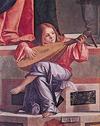- lute
-
lute1
n.1. a stringed musical instrument having a long, fretted neck and a hollow, typically pear-shaped body with a vaulted back.v.i.2. to play a lute.v.t.4. to express (a feeling, mood, etc.) by means of a lute: The minstrel eloquently luted his melancholy.[1325-75; ME < MF, OF < OPr laut < Ar al 'ud lit., the wood]lute2n.1. luting.v.t.2. to seal or cement with luting.[1375-1425; late ME < ML lutum, special use of L lutum mud, clay]lute3n.1. a paving tool for spreading and smoothing concrete, consisting of a straightedge mounted transversely on a long handle.v.t.2. to spread and smooth (concrete in a pavement) with a lute.[1870-75, Amer.; < D loet]
* * *
It originated from the Arab ūd, which reached Europe in the 13th century. Like the ʽūd, the lute has a deep pear-shaped body with an ornamental soundhole, a fretted neck with a bent-back pegbox, and strings hitched to a bridge glued to the instrument's belly. In later years it acquired several unstopped bass strings. It became the preferred instrument for cultivated amateur musicians and acquired an extensive literature of song accompaniments and solo and consort music. Angel playing a lute, from "Presentation in the Temple," painted altarpiece by Vittore ...SCALA-Art Resource
Angel playing a lute, from "Presentation in the Temple," painted altarpiece by Vittore ...SCALA-Art Resource* * *
in music, any plucked or bowed chordophone whose strings are parallel to its belly, or soundboard, and run along a distinct neck or pole. In this sense, instruments such as the Indian sitar are classified as lutes. The violin and the Indonesian rebab are bowed lutes, and the Japanese samisen and the Western guitar are plucked lutes.In Europe, lute refers to a plucked stringed musical instrument popular in the 16th and 17th centuries. The lute that was prominent in European popular art and music of the Renaissance and Baroque periods originated as the Arab ūdʿ. This instrument was taken to Europe in the 13th century by way of Spain and by returning crusaders and is still played in Arab countries. Like the ʿūd, the European lute has a deep, pear-shaped body, a neck with a bent-back pegbox, and strings hitched to a tension, or guitar-type, bridge glued to the instrument's belly. European lutes have a large, circular sound hole cut into the belly and ornamented with a perforated rose carved from the belly's wood.The earliest European lutes followed the Arab instruments in having four strings plucked with a quill plectrum. By the mid-14th century the strings had become pairs, or courses. During the 15th century the plectrum was abandoned in favour of playing with the fingers, movable gut frets were added to the fingerboard, and the instrument acquired a fifth course. By the 16th century the classic form of the lute was established, with its six courses of strings (the top course a single string) tuned to G–c–f–a–d′–g′, beginning with the second G below middle C. Playing technique was systematized, and the music was written in tablature (a system of notation in which a staff of horizontal lines represented the courses of the lute), and letters or figures placed on the lines denoted the fret to be stopped and the strings to be plucked by the right hand.By 1600 the great Bolognese and Venetian schools of lute makers had arisen, including Laux and Sigismond Maler, Hans Frei, Nikolaus Schonfeld, and the Tieffenbruckers. By the fine workmanship and tonal proportions of their instruments, they contributed much to the popularity of the lute and paved the way for its extensive and noble literature of solo music (fantasias, dance movements, chanson arrangements), song accompaniments, and consort music by such composers as Luis Milán and John Dowland.After about 1600, modified tunings were introduced by French lutenists. At the same time, the lute itself was altered by the addition of bass strings, or diapasons, which required the enlargement of the neck and head of the instrument. Such modified instruments were called archlutes (archlute) and included the chitarrone and the theorbo (qq.v.).A smaller archlute, known as the theorbo-lute (so called because it resembled the theorbo), or French lute, was used by the 17th-century French school of lutenists, including Jacques and Denis Gaultier. This instrument's repertory required a highly mannered and ornamented style of performance and a new technique of broken chords and slurred notes that exerted a marked influence on 17th-century harpsichord composers.By the 18th century, keyboard instruments eclipsed the lute in popularity. Twentieth-century lutenists such as Julian Bream and Walter Gerwig (d. 1966) successfully revived the lute and its repertory. In the early 21st century, the lute could readily be heard in performances and recordings by artists such as Jakob Lindberg, Nigel North, Paul O'Dette, and Hopkinson Smith, all of whom also taught in universities or conservatories. The lute became a “crossover” instrument when the rock musician Sting released recordings of Dowland's music in 2006 and 2007.* * *
Universalium. 2010.
